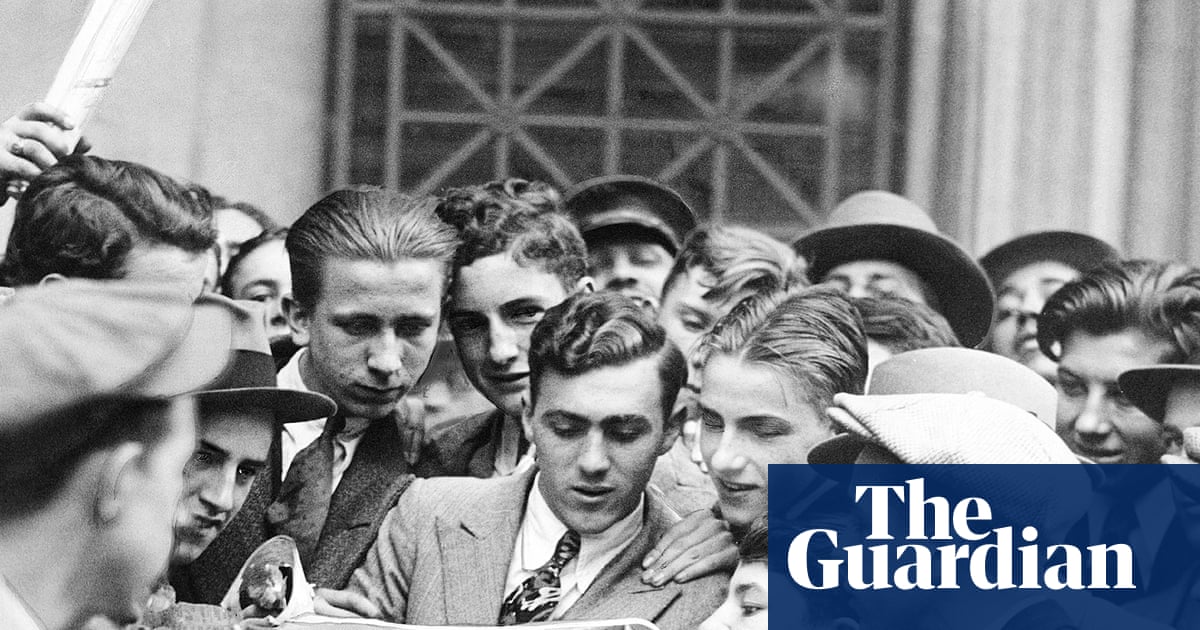Thieves escaped on a scooter with nine items of jewellerypublished at 10:51 BST
Breaking
Hugh Schofield
Paris Correspondent
Details are sketchy but French media are reporting that three masked men broke into the Louvre shortly after…

Breaking
Hugh Schofield
Paris Correspondent
Details are sketchy but French media are reporting that three masked men broke into the Louvre shortly after…

The 2025 European Le Mans Series season was brought to a fitting close with a dramatic four hour race at the Autodromo Internacional do Algarve that saw the LMP2, LMP2 Pro/Am and LMGT3 titles decided right at the chequered flag.
The LMP2 title was…

XYMAX REIT Investment (TSE:3488) delivered a 9.1% increase in earnings this year, building on a robust 5.5% annual growth rate over the past five years. Net profit margins ticked up to 50% from 48.5% last year. High-quality earnings further underpin this performance. With the company recognized for strong value and consistent profit growth, investors are weighing improving profitability against lingering questions about the balance sheet and dividend sustainability.
See our full analysis for XYMAX REIT Investment.
Next, we will see how these results compare with market expectations and popular narratives, highlighting where reality and market perception may diverge.
Curious how numbers become stories that shape markets? Explore Community Narratives
Net profit margin improved from 48.5% to 50% year-on-year, underscoring that profitability is trending higher rather than just staying stable.
Strong margins heavily support the claim that XYMAX REIT’s consistent distribution track record and occupancy stability make it attractive for investors seeking yield and income reliability.
At the same time, the modest margin jump clarifies this performance comes without aggressive moves, reinforcing the view that stability is a central pillar instead of rapid growth.
Prevailing market view emphasizes how the firm’s margin resilience signals a defensive profile, fitting investor appetites for safety amid modest economic recovery and sector caution.
This supports the idea that steady, high margins can justify a valuation premium during market risk aversion, even when aggressive expansion is not on the table.
However, with only a slight margin uptick, the company may underwhelm those looking for more dynamic, growth-driven upside.
The current Price-To-Earnings ratio is 17x, lower than both the JP REIT industry average (20.2x) and peer average (17.7x). However, the share price of ¥119,700 exceeds the estimated fair value of ¥113,923.04.
Prevailing market view notes that while XYMAX REIT appears a bargain relative to sector multiples, buyers are paying a small premium above fair value for its perceived income stability.
This contrast highlights a trade-off: the REIT trades at a discount to peers but not to its intrinsic worth, so some caution is warranted if broader market risk appetite returns or sector leaders begin to grow faster.
Even with this valuation setup, the share price may reflect a safety premium, especially when steady distribution and high margins outweigh the lack of visible growth initiatives.
As sector conditions remain cautious and income predictability is prized, this valuation standoff could persist until a clear catalyst tips sentiment toward value or growth.
Investors looking for deep value should be mindful that the stock does not currently trade below fair value, despite its discounted P/E multiple.

Aeluma, Inc. recently completed its underwritten public offering, raising approximately US$25.4 million in gross proceeds and boosting its cash position to about US$38 million to invest in manufacturing partnerships and engineering talent.
This significant cash increase could further position Aeluma for operational expansion through new hires and enhanced manufacturing capabilities.
To assess how these developments affect Aeluma’s investment narrative, we’ll focus on the company’s increased capacity to invest in growth initiatives.
Uncover the next big thing with financially sound penny stocks that balance risk and reward.
To own shares in Aeluma today is to believe the company can turn rapid revenue growth and cutting-edge photonics into lasting profitability, even in a competitive and volatile sector. The recent US$25.4 million public offering lifts Aeluma’s cash reserves to around US$38 million, giving the company more room to pursue manufacturing partnerships and attract engineering talent. This extra cash could accelerate key short-term catalysts like new product launches and customer wins, while potentially reducing worries about near-term funding pressures. Still, with a recent uptick in insider selling and a history of substantial shareholder dilution, questions remain about how quickly the business can transition from high growth to sustainable profit. The fresh cash raises the company’s ceiling for expansion, but does not remove risks around execution, dilution, or path to profitability. In contrast, investors should keep an eye on the ongoing dilution risk and shifting capital needs.
Our valuation report unveils the possibility Aeluma’s shares may be trading at a premium.
Opinions from 4 Simply Wall St Community members peg Aeluma’s fair value anywhere from US$1.58 to US$25.50 per share. With such a wide range of estimates and the company recently strengthening its cash reserves, views on Aeluma’s future profitability and dilution risk continue to divide market participants. Explore these different viewpoints to better understand both the opportunity and the uncertainty.
Explore 4 other fair value estimates on Aeluma – why the stock might be worth as much as 53% more than the current price!
Disagree with this assessment? Create your own narrative in under 3 minutes – extraordinary investment returns rarely come from following the herd.

Damien Wilde / Android Authority
Samsung’s Galaxy Store has been around for a long time, and it’s where you’d go to download and update Samsung apps, Galaxy Themes, apps for your Tizen smartwatch, and more. In recent years, however, the…

Lisa Tertsch is the new triathlon world champion. The German won the women’s elite finals of the 2025 World Triathlon Championship Series in Wollongong this Sunday, 19 October.
The victory enabled her to succeed defending world champion,

Andrew Ross Sorkin’s first book, Too Big to Fail, was a bestseller about the financial crisis of 2008, published the following year. His second, 1929, out this week, takes readers “Inside the Greatest Crash in Wall Street History – and How it Shattered a Nation”.
It’s been 16 years between books, but Sorkin hasn’t been idle. A columnist for the New York Times, he founded its DealBook newsletter and summit; he’s a Squawk Box co-anchor for CNBC; and after Too Big to Fail was filmed by HBO, he co-created Billions, a huge hit for Showtime starring Damian Lewis and Paul Giamatti.
After Too Big to Fail, Sorkin said, he was “often asked about 1929. I actually didn’t know much. I had read JK Galbraith [The Great Crash, 1929, published in 1955] and a couple other books. And most people I knew, we would all sort of talk about 1929 as this terrible calamity, but nobody … knew what actually happened – who the people were, what they said to each other, what the motivations were, what the incentives were, what the lessons actually were.”
The short version of what happened in 1929 is that a stock market built on fast credit and wild speculation suffered a series of falls culminating in the Black Thursday crash on 24 October, in Galbraith’s words a day “measured by disorder, fright, and confusion”.
Combined with factors including protectionist tariffs and rising unemployment, the crash was a key signpost to a devastating global depression.
“About a decade ago,” seeking a way into the story, Sorkin went on vacation and “like a real nerd, downloaded some books to a Kindle … and I remember reading them, thinking: ‘Wow, this is so much more interesting than I knew,’ but also feeling most of the books about this period were written in the 1930s, some in the 40s, 50s. I think there’s one that was maybe the 70s. And a lot of them were written by economists … told through charts and data and economic systems. And I wanted the human drama.
“One of the lessons of writing Too Big to Fail was, we talk about business and the economy oftentimes in big numbers and structures and systems, but it really is ultimately about people and the decisions they make. So I thought: ‘Maybe there’s an opening to write a book like that.”
A visit to Harvard allowed a look at the papers of Thomas Lamont, a partner at JP Morgan, including transcripts of White House talks with President Herbert Hoover. Allowing for myriad commitments and the challenges of pandemic-era research, Sorkin’s book was a go.
As influences for a book based on first-hand sources found in countless archives, Sorkin cites business classics: Den of Thieves by James B Stewart, about insider trading; Liar’s Poker by Michael Lewis, about bonds traders; and Barbarians at the Gate by Bryan Burrough and John Helyar, about the fall of RJR Nabisco.
“Widening the aperture”, a phrase Sorkin uses to describe a project that encompasses earlier panics (1907, 1921) and the long aftermath of 1929, he also looked to Walter Lord’s A Night to Remember, from 1955, as “really the definitive in-the-room account of the sinking of the Titanic” and “actually a little bit like a mental model … [for] a way I wanted the reader to be able to feel.”
The crash of 1929 was indeed like a shipwreck. Livelihoods were lost when the market capsized, though Sorkin confirms that one image in the popular imagination, of ruined brokers leaping from Wall Street windows, is not what actually happened. For a while, it seemed the economy might recover. It took other factors, prominently including the Smoot-Hawley Tariff Act of 1930, to bring about depression.
As Sorkin’s book comes out, Donald Trump’s tariffs and their effects are in the news. Sorkin said he wrote with an eye on current events but preferred not to oversell such parallels, instead seeking chiefly to present relatable characters.
“I’m always trying to understand where the drive comes from, where the motivation comes from, for whatever the decision is that people are making,” Sorkin said, citing experience gained “in the context of Billions and the making of the movie Too Big to Fail” as well as “what I try to do with my journalism every day.
“Oftentimes it was to try to understand: ‘Well, what is it that’s driving Charlie Mitchell?’ … or: ‘What was it about Carter Glass in his childhood that led him to be this sort of very unique character?’ Similarly with Lamont and John Raskob and so many others.”
Mitchell, CEO of National City Bank, a casualty of the crash, was hauled before Congress and into court on tax charges. Glass was a senator from Virginia who drove reform to protect ordinary Americans from Wall Street excess. Raskob, an executive at DuPont and General Motors, chaired the Democratic National Committee.
One way Sorkin seeks to make such characters relatable is to depict their use of technology to master fast-moving markets – analog telephones in serried ranks on desks above Wall Street now home to computers. He’s also happy to compare key players to equivalents today.
Considering Glass, a Virginia conservative, Sorkin looks to a current senator from Massachusetts, decidedly more progressive, the force behind the Consumer Financial Protection Bureau, formed after 2008 to protect ordinary investors.
“If Elizabeth Warren was a racist, that’s who [Glass] would be,” Sorkin laughed. “But what, to me, was so interesting about [Glass] was also that … he was cited after the 2008 financial crisis as one of the great bastions of the regulatory world. I think liberals really loved him. They thought that he was really trying to hold Wall Street to account.
“And I went into this project thinking about that narrative, and … as the story progresses, it is so much more complicated than that. I’m not sure Elizabeth Warren would be citing Carter Glass today if she really understood the full dynamic of how the Glass-Steagall Bill was created.
“I thought of Glass-Steagall [also named for Henry B Steagall, a congressman from Alabama] as this famous bill that broke up the banks and was really meant to end the casino [gambling on the markets], and then you realize … the real movers weren’t even politicians, to some degree they were bankers who were trying to screw each other. And maybe it just represents how this world is actually no different than it is today, in many ways, in terms of how the sausage gets made.”
Among those bankers, Sorkin found Mitchell “sort of a villain, but not really” and compelling because “I love characters that are not black and white. And he was so interesting to me because he was as famous as Jamie Dimon [CEO of JPMorgan Chase] would be today. But there were aspects of [Mitchell] that might have been more like a Michael Milken,” the insider trader jailed in 1990 then pardoned by Trump in 2020.
“Charlie Mitchell created credit and leverage in the system to loan money to ordinary investors, which in large part is what led to the crash. Michael Milken revolutionized the debt markets and the credit markets in the 80s by loaning high-yield bonds, or what people call junk bonds, to less good credits. And they both were arrested. The outcome was slightly different, but they were both hated.”
Knowing today’s titans well – it was his question that memorably prompted Elon Musk to tell critics “go fuck yourself” – Sorkin is well placed to make comparisons. Regarding another key character in 1929, the Tesla, SpaceX and X owner duly enters the chat.
“To me, John Raskob is like Elon Musk. Think about a businessman who was involved in everything. Cars, obviously, General Motors, and [Raskob] gets involved in politics … starting to try to damage the reputation of Hoover by doing all of these back-channel projects. And then he’s building the equivalent of a spaceship, the Empire State Building. And he also happens to have 13 children.”
Among the supporting cast, there’s Hoover, the technocratic president who rebranded the post-crash “panic” as a “depression”, inadvertently sealing his reputation as a failure, left to watch Franklin D Roosevelt save the day. Sorkin also depicts Winston Churchill, a decade away from his finest hour as British prime minister, in debt to his shirtmaker, playing the Manhattan markets anyway, wandering Fifth Avenue, there to be hit by a car.
Financial calamity brings political fallout. In the second half of 1929, Sorkin’s story moves to Washington and attempts to hold Wall Street accountable. As in 2008, most main players avoided serious penalties.
Clearly, Sorkin is going to get more questions about what 1929 might teach us about 2025 and a US economy showing signs of trauma, Trump-induced or not.
He said: “There are a lot of parallels that I imagine people could draw out. I mean, look at the idea today and the idea back then of democratizing finance.”
In 1929, “democratizing finance” meant opening the markets to ordinary Americans through unchecked credit.
“Today,” Sorkin said, “what do they talk about democratizing finance? They just passed a bill that Trump signed that’s going to allow private equity and venture capital and private credit into your 401(k) plan. That’s all about democratizing finance. Crypto is now a thing that’s about democratizing finance. Obviously, the tariffs are almost a super-direct parallel.”
Another Trump obsession, bending the central bank to his will, is also foreshadowed in Sorkin’s book.
“There’s the whole debate the Fed is having in the spring of 1929 about whether to raise or lower interest rates,” Sorkin said. “To some degree, [there are] even debates about the independence of the Fed … So I think there’s lots of things that do seem familiar.”

When it comes to troubleshooting misbehaving technology, we’ve got more options than ever before. Between first- and third-party software solutions and online forums dedicated to troubleshooting and fixing common problems, we’re spoiled for…